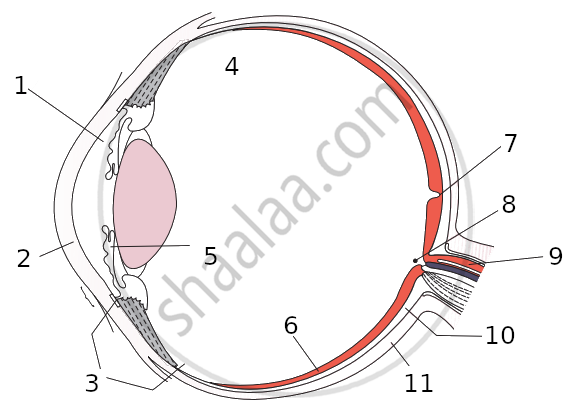Advertisements
Advertisements
प्रश्न
Explain the structure and functioning of Human eye. How are we able to see nearby as well as distant objects?
उत्तर
- Structure of the human eye: Cornea is the transparent window of the eye that serves in the refraction of most of the light rays entering the retina. Iris is the coloured part of the eye that controls the amount of light by regulating the pupil size. The pupil is a hole shaped opening in the middle of the eye. The retina is the innermost layer of the eye and contains an outer pigmented layer and an inner nervous layer. It has photoreceptors (rods and cones). The optic nerve consists of nerve fibres from the innermost layer of the retina and serves to transmit the impulse to the brain. The eye lens is made up of fibrous, jelly-like material and transparent structure. It serves to form an inverted real image of the object on the retina. Vitreous humour is clear, a semi-solid structure that supports the eyeball.

- Functioning of the human eye: Light enters the eye through the pupil and then the eye lens converges these light rays on the retina. An inverted real image of the object is formed on the retina and image-electric signals are sent to the brain via the optic nerves. The brain reconstructs the erect image of objects and we can see the objects.
We are able to see nearby as well as distant objects due to the eye’s ability to adjust its focal length which is known as the power of accommodation. Relaxation of muscles makes the lens thinner and its focal length increases to make us see the distant objects clearly. Contraction of ciliary muscles increases the curvature of the eye lens and makes the eye lens thicker. Consequently, the focal length of the eye lens decreases. This enables us to see nearby objects clearly.
APPEARS IN
संबंधित प्रश्न
What changes the shape of lens in the eye?
The human eye possesses the power of accommodation. This is the power to:
(a) alter the diameter of the pupil as the intensity of light changes
(b) distinguish between lights of different colours
(c) focus on objects at different distances
(d) decide which of the two objects is closer.
How much is our field of view:
with both eyes open?
State the main functions of the following:
Seminal Vesicles
Differentiate between:
Vitreous humour and Aqueous humour.
Complete the following sentence with appropriate Word
The part of the human eye where rod cells and cone cells are located is the:
Write an Explanation.
Minimum distance of distinct vision
The coloured portion of the eye is the ______.
Select the option with incorrect identification:

Name the following:
Three layers of the eye ball.
